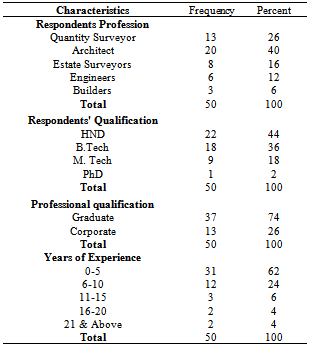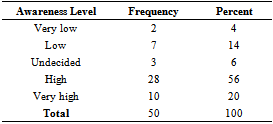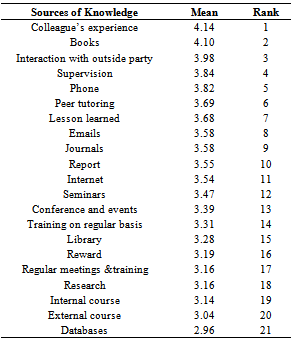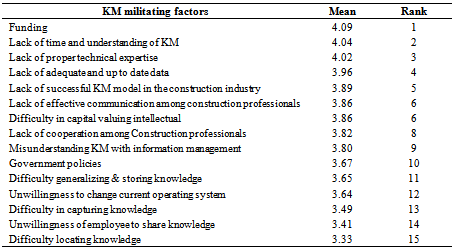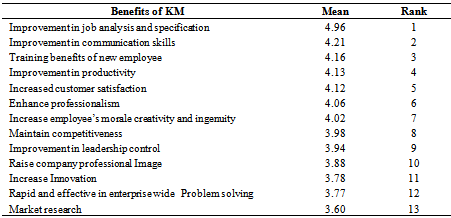-
Paper Information
- Paper Submission
-
Journal Information
- About This Journal
- Editorial Board
- Current Issue
- Archive
- Author Guidelines
- Contact Us
International Journal of Construction Engineering and Management
p-ISSN: 2326-1080 e-ISSN: 2326-1102
2013; 2(3): 85-92
doi:10.5923/j.ijcem.20130203.06
Assessment of Knowledge Management Practices among Construction Professionals in Nigeria
Oke A. E., Ogunsemi D. R., Adeeko O. C.
Department of Quantity Surveying, Federal University of Technology, P. M. B. 704, Akure, Nigeria
Correspondence to: Oke A. E., Department of Quantity Surveying, Federal University of Technology, P. M. B. 704, Akure, Nigeria.
| Email: |  |
Copyright © 2012 Scientific & Academic Publishing. All Rights Reserved.
This research work examined the areas of the construction industry that will improve as a result of the contributions of knowledge management. Data for the analysis were collected through questionnaires administered on construction professionals using convenient sampling method. The study revealed that the knowledge management adoption is being hindered the most in Nigeria by funding as there is no adequate fund to carry it out in construction organizations. In conclusion, it was observed that colleague’s experience was ranked first among the sources of knowledge available to construction professionals in Nigeria as most construction professionals in Nigeria don’t read much and are not exposed to other methods of acquiring knowledge within the organisation, and fund is the highest ranked problem hindering the adoption of knowledge management among Construction Professionals. It was then recommended that Civil Engineers, Builders, Middle managers, Lower managers and Technicians should improve in the level at which they transfer and share knowledge with other construction professionals and that the Federal Government of Nigeria should inject more fund to the construction industry of the country as this is a very productive sector of the economy.
Keywords: Construction Industry, Construction Professionals, Knowledge Management, Nigeria
Cite this paper: Oke A. E., Ogunsemi D. R., Adeeko O. C., Assessment of Knowledge Management Practices among Construction Professionals in Nigeria, International Journal of Construction Engineering and Management , Vol. 2 No. 3, 2013, pp. 85-92. doi: 10.5923/j.ijcem.20130203.06.
Article Outline
1. Introduction
- According to[1], knowledge management (KM) is a process of systematic management of vital knowledge and its associated process of creating, gathering, organising, diffusion, use and exploitation. It requires turning personal knowledge into corporate knowledge that can be widely shared throughout the organisation. All organisations are awash with information and knowledge. The problem is that it is invisible and most people in organisations simply don’t know what their colleagues know. The organisations don’t know what their employees know, nor do they have any way to find out or organise it. They typically have fewer grips on the knowledge available outside – owned by competitors, suppliers, universities and the government.Knowledge management is about getting the right knowledge to the right people at the right time. Knowledge management according to[2] is about sharing and acquiring knowledge in ways that can be translated into improved organizational performance. The intellectual capital of individuals and teams are presented in a tangible form that facilitates the adding of value to the organization and ultimately its customers[3]. This process of added value is achieved through continuous recycling and creative use of shared knowledge and experience. This is followed by the structuring of shared competencies with the help of technology, process maps and descriptions, manuals, networks and so on, to ensure that competence remains in the organization even when staff leaves. The knowledge, once packaged, becomes part of the capital of the organization. This creates an environment for the rapid sharing of knowledge as well as sustained and collective knowledge growth. Lead times between learning and knowledge sharing are shortened and human capital becomes more productive through intelligent work processes. Knowledge management is about acquiring, structuring, and transmitting intellectual material for the benefit of the organization. One of the major misconceptions of knowledge management is that it is about information technology[4]. Knowledge management application among construction professionals in developing economy is still an under chartered territory hence its role and application cannot be over emphasized.[5] believed that the role of knowledge management is to identify what information and knowledge is important to the organisation, finding out where it is held, and mobilising it so that staff can apply it in their work.However, it is now being recognised that the management of project knowledge (especially within the construction industry where projects are implemented by temporary 'virtual' organisations) is open to considerable improvement, both within construction organisations, and between firms in the supply chain[6]. The emphasis on Knowledge Management according to[7] reflects the growing realisation that it is a core business concern, particularly in the context of the emerging knowledge economy, where the know-how of a company is becoming more important than the traditional sources of economic power (capital, land, etc.)Given the relative importance of the construction sector to the Nigerian economy, this seems to present a fruitful area for investigation. KM has become an increasingly important issue due to rapid changes in market conditions, competition and technological developments, which have led to changes in the way work is organized. KM is considered vital for the survival of organizations. It is asserted that knowledge is fast overtaking capital and labour as the key economic resource in advanced economies[8]. Within the construction industry, it is increasingly being acknowledged that KM can bring about the much needed innovation and improved business performance the industry requires. The aim of this study is to examine the ways by which knowledge is being transferred among construction professionals and impact on project delivery.
2. Literature Review
2.1. Construction Professionals in Nigeria
- The construction industry is made up of both the formal sector and informal sector, with the formal sector consisting of organized companies. Due to the multi disciplinary nature of the industry the formal sector consist of the Architects, the Quantity Surveyors, the Estate Surveyors, the Civil Engineers and the Builders. All these professionals join forces together to promote the construction industry. The informal sector consist of trades and artisans; but for this purpose, knowledge is acquired transferred and managed within the industry with the construction professionals responsible for these.The construction of a project of any kind be it building, civil or heavy engineering works involves the services of many people directly and indirectly[9]. These are people responsible for the overall design, construction and maintenance of a construction project from inception to completion. They are even involved in the sales and/or letting of the property on practical completion. Hence they carry the course of construction industry’s workload and most of the construction project managers available today are construction professionals that have construction knowledge as background. However it is necessary to have a thorough knowledge of the professionals in the industry and the interrelationship that exist between them.[10] affirms from observation that, there seems to be confusion and misinterpretation of the roles of these professionals within the construction industry in developing countries in general and in Nigeria in particular due to many factors. One of which is lack of proper working knowledge on the part of majority of people as to the roles of each professionals in the industry. It was further that the construction industry is unique when compared with other industries in terms of design and manufacturing of its product in which case the design phase is separated from the construction phase (except for some modern procurement method). While Architect and some sections of the engineering profession (civil engineers) carry out the design of the buildings, the cost control and the construction is the role of the Quantity Surveyors and builders respectively. The Estate Surveyors on the completion of the project is responsible for its marketing through outright sales, leasing or letting as appropriate.
2.2. Knowledge Management and the Construction Industry
- Knowledge management has become an increasingly important issue due to rapid changes in markets conditions, competition and technological developments which have led to changes in work and the way work is organized. Knowledge management is considered vital for the survival of organization. It is asserted that knowledge is fast overtaking capital and labour as the key economic resource in advanced economies[8]. Knowledge management is particularly important for the construction industry, for at least three main reasons. Firstly, the construction industry is widely perceived as an industry with low productivity and poor performance despite its importance in the national economy. Hence, there is a need for KM to improve the existing processes and management of construction companies[11]. Secondly, the project-based nature of the industry has made it particularly important to record and transfer lessons from one project to another[12]. Thirdly, construction companies today face various challenges and new solutions are necessary to meet the growing demand for new types of buildings and structures[13].It is widely accepted that the current market dynamics and the trends towards specialized and customer-oriented services in the construction industry demand a more efficient and effective application of knowledge within corporate as well as project organizations[14];[15];[16];[12]. A number of researchers have acknowledged the limitations of current approaches to managing information and knowledge relating to and arising from a construction project[11];[13];[14];[15]; [12].[11] states that the lessons learnt in SA construction projects are not organized well and are buried in details. This makes it difficult to compile and disseminate useful knowledge to other projects. The fragmentation of the construction industry has also been identified as a critical barrier to achieving efficient communication among parties (and individuals) within a project team working together on construction projects[13];[14];[17];[12]. Reviewing the literature on knowledge management in construction reveals that knowledge can be captured, created, stored, used, protected and essentially managed, not unlike any other economic commodities[18]. Thus it can be put together as bits, bytes, and packages for ease of transfer through the use if ICT[19]. The initiative, explicit and factual nature of knowledge makes it amenable to ICT manipulation. However upon closer inspection it is not clear in what sense knowledge is different from information. Information represents data arranged in a meaningful pattern; where intellectual input has been added to raw data, data in turn represents raw numbers, images words and sounds which are derived from observation or measurements. Although information is required for the creation of knowledge but knowledge makes information meaningful and guides to what data to be collected, thus the dynamic nature of knowledge[20]
2.3. Role of ICT in Knowledge Management
- [21] observed that Information Technology (IT) has long been recognized as critical for successful knowledge management. This is probably a legacy of the growth in knowledge based systems (KBS) in the 80s and early 90s, and has led to much of the early work on knowledge management focusing on the delivery of technological solutions. While it is now recognized that good knowledge management does not result from the implementation of information systems, the role of IT as a key enabler remains undiminished[14].[4] classified information systems for knowledge management into four main categories: • Those for creating knowledge (knowledge work systems): these support the activities of highly skilled knowledge workers and professionals as they create new knowledge and try to integrate it into firms; • Those for distributing knowledge (office automation systems): these help disseminate and co-ordinate the flow of information in an organization; • Those for sharing knowledge (group collaboration systems): these support the creation and sharing of knowledge among people working in groups; and• Those for capturing and codifying knowledge (artificial intelligence system): these provide organizations and managers with codified knowledge that can be reused by others in the organization.
2.4. Barriers to Knowledge Management in the Construction Industry
- The typical construction organization does not encourage the culture of sharing knowledge. Wates Group, a medium sized UK building company, stated it took four and a half years before staff accepted the concept of sharing knowledge[22]. Primarily, the cultures of the organizations need to be addressed if KM is to be of benefit. Each organization has its individual culture and only they can say what initiatives need to be set up to encourage a culture change. There are many other barriers to the successful implementation of KM within a construction enterprise. These according to[20] include: Lack of Time; Trying to solve large problems; Converting Knowledge; Large number of SMEs; Multi- Disciplinary Teams; Unique Projects; Lack of Learning; Lengthy Time Period; Loss of faith; and IT Support
2.5. Requirements of a Knowledge Management System
- For any IT system to be classified as a Knowledge Management system according to[19], it must fulfil a number of requirements:1. It must support the full KM lifecycle – from knowledge creation through distribution and management to retirement – and not just a subset thereof.2. There should be appropriate mechanisms for validation and authentication of the knowledge encapsulated in the system. 3. The system should be able to seamlessly integrate with existing legacy IT systems within a real or virtual organization. 4. Flexibility and ease of use are essential components of the system, as they are crucial for ensuring its acceptability and utilization.5. The knowledge contained within the system must be well maintained and up-to-date. This is essential for building up user confidence in the system and ensuring that decisions are based on the latest information available.6. The system must be designed in accordance with an organization’s goals, culture and business processes. End-user involvement in the design and implementation of the system is crucial in this regard.
2.6. Knowledge Management, Intellectual Capital and Innovation
- Innovation is a complex phenomenon. Despite diverse perspectives, many researchers are in agreement on the importance of innovation as a pre-requisite for competitive advantage. Innovations come from many different sources and exist in many different forms. In order to create an environment conducive to innovation, it could be argued that there needs to be an effective management of this complex process[25]. Thus, increased attention is focused on KM and IC management as a possible pre-requisite to successful innovation. In the last decade there has been a shift in management focus from traditional accountancy practices where financial capital is paramount, to growing realization that intangible assets are of greater significance in our knowledge-based economy[26]. However, the Gottlieb Duttweiler Foundation found that only 20% of knowledge available to an organization is actually used[27].Knowledge can be a valuable resource for competitive advantage and harnessing its value is one of the pre-eminent challenges of management. Identifying and exploiting knowledge assets, or intellectual capital (IC), has been vastly documented. There are different types of knowledge in an organization from the tacit knowledge of individuals, which is unarticulated and intuitive, to explicit knowledge that is codified and easily transmitted[28]. Further distinctions have been made by academics and practitioners involved in the IC debate. Three components of IC have been identified comprising human, structural and customer capital[19]. Clearly, structural capital describes the internal structure of an organization, such as its strategies, core competencies and culture, which is always context specific. Customer capital encompasses the external intangible assets of an organization. External forces play a part in determining the market position and strength of an organization. Customers are the principal determinants of this position as observed by[27]However, it is asserted that the human capital in an organization is the most important intangible asset, especially in terms of innovation[8];[19]. The unique tacit knowledge of individuals is of immense value to the organization as a whole, and is the “wellspring of innovation”[19]. Identification of the different types of knowledge available to an organization is the first step to understanding how to manage them. Therefore, KM is intrinsically linked to IC as revealed by[29]. There are many definitions of KM. However, an operational definition has been developed for the purposes of this research. KM is about the processes by which knowledge is created, captured, stored, shared, transferred, implemented, exploited and measured to meet the needs of an organization. These processes lead to the establishment of a knowledge-based organization. A thorough review of the relevant literature and discussions with targeted researchers in the field would suggest that the development of successful knowledge management programmes involve due cognizance of many factors. They involve 'hard' (e.g. technology) and 'soft' (e.g. people, culture, leadership) issues.
3. Research Methodology
- This research was designed to use survey to prepare a mental plan for solving the problem in systematic manner. It involved assessing the public opinion through the collection of detailed data of the existing circumstances on knowledge management sharing, transfer, sources, and problems and using the data collected to justify the current conditions in order to make improvement in the construction industry. The focus of interest of this study were the knowledge workers in the construction industry such as Engineers, Quantity Surveyors, Estate Valuers, Architects, and Builders in Nigeria. Structured questionnaires were self administered to 65 construction professionals in the industry and 50 of them representing about 77% of the overall total number of questionnaires were suitable for analysis. The questionnaires were directed to all knowledge workers involved in the construction industry as they are expected to know how to respond to the questions being asked and identify most of the facts that will lead to reliable conclusions. Questions were asked in order to ascertain the ways they manage knowledge, the aspect of the construction industry that will improve as a result of improvement in knowledge sharing and transfer among construction industry. It is based on these responses and findings that conclusions were drawn using frequency and mean item score statistical tools.
4. Results and Discussion
- In order to assess the characteristics of respondents for the study, the following data were collected: respondents’ profession; highest academic qualification; professional qualification of respondents; and the years of experience.Table 1 shows the characteristics of the respondents used for the study, as shown in the table, 40% of the questionnaire was administered among the architects and 26% among the Quantity surveyors. Among the respondents 37% were graduates in their various professions. Thus, with the information provided in the Table 1, the data provided by the respondents can be relied upon for the purpose of the analysis.
|
|
|
|
|
|
|
5. Conclusions and Recommendations
- The study revealed that colleagues’ experience is the ready source of knowledge that is available to construction professionals in Nigeria. This revealed that Nigerian construction professionals rely mostly on what their colleagues share with them. The study also concluded that Architects are the construction professionals that share and transfer knowledge the most with other professionals in the industry. It was also revealed that all elements of the construction industry will improve with effective Knowledge Management.Problem hindering the adoption of Knowledge management the most in the construction industry is funding while the least is difficulty in locating knowledge. More so, the major factors that contribute to the success of knowledge management in the construction industry are top management support, employee active participation, application of IT and creation of knowledge sharing space.There is a need for construction professionals to embrace the use of ICT since the application of ICT to knowledge management would make their jobs easier and facilitate good and instant result. More so, the government and other construction professionals should inject fund into knowledge management aspect of the construction industry so that the benefits that are derived from this area can be harnessed.
 Abstract
Abstract Reference
Reference Full-Text PDF
Full-Text PDF Full-text HTML
Full-text HTML